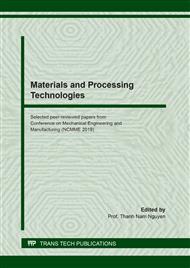[1]
O. S. Es-Said, J. Foyos, R. Noorani, M. Mendelson, and R. Marloth Effect of Layer Orientation on Mechanical Properties of Rapid Prototyped Samples, 2000, Materials and Manufacturing Processes.
DOI: 10.1080/10426910008912976
Google Scholar
[2]
Jaya Christiyana KG, Chandrasekharb U, Venkateswarluc K (2016) A study on the influence of process parameters on the mechanical properties of 3D printed ABS composite,. MaterSci Eng114(01):1–6.
Google Scholar
[3]
Godfrey C. Onwubolu and Farzad Rayegani Characterization and Optimization of Mechanical Properties of ABS Parts Manufactured by the Fused Deposition Modelling Process, 2014, International Journal of Manufacturing Engineering.
DOI: 10.1155/2014/598531
Google Scholar
[4]
Hutmacher DW, Schantz T, Zein I et al (2001) Mechanical properties and cellcultural response of polycaprolactone scaffolds designed and fabricated via fused deposition modeling,.J Biomed Mater Res55(2): 203–216.
DOI: 10.1002/1097-4636(200105)55:2<203::aid-jbm1007>3.0.co;2-7
Google Scholar
[5]
Mohammad Shojib Hossain, David Espalin, Jorge Ramos, Mreye Perez, Ryan Wicker Improved Mechanical Propertie s of Fused Deposition Modeling - Manufactured Parts Through Build Parameter Modifications, 2014, Journal of Manufacturing Science and Engineering.
DOI: 10.1115/1.4028538
Google Scholar
[6]
Mst Faujiya Afrose , S. H. Masood , Pio Iovenitti , Mostafa Nikzad , Igor Sbarski Effects of part build orientations on fatigue behavior of FDM-processed PLA material, 2015, Springer International Publishing Switzerland (2015).
DOI: 10.1007/s40964-015-0002-3
Google Scholar
[7]
B.H. Lee, J.Abdulla, Z.A Khan (2005). Optimization of rapid prototyping parameters for production of flexible ABS object,. Jounal of material processing technology169 (2005) 54-61.
DOI: 10.1016/j.jmatprotec.2005.02.259
Google Scholar
[8]
Bellehumeur CT, Gu P, Sun Q, Rizvi GM (2008) Effect of processing conditions on the bonding quality ofFDM polymer filaments,. Rapid Prototype J 14(2):72–80.
DOI: 10.1108/13552540810862028
Google Scholar
[9]
Anoop K.Sood, Rai K.Ohdar, Siba S.Mahapatra. Experimental investigation and empirical modeling of FDM process foe compressive strength improvement,. Journal of advance research (2011).
DOI: 10.1016/j.jare.2011.05.001
Google Scholar
[10]
Ahn SH, Montero M, Odell D, Roundy S, Wright PK. Anisotropic material properties of fused deposition modelling ABS,. Rapid Prototyp J 2002; 8(4):248–57.
DOI: 10.1108/13552540210441166
Google Scholar
[11]
Khan ZA, Lee BH, Abdullah J. Optimization of rapid prototyping parameters for production of flexible ABS object,. J Mater Process Technol 2005; 169:54–61.
DOI: 10.1016/j.jmatprotec.2005.02.259
Google Scholar
[12]
C. F. Jeff Wu and Michael Hamada, Experiments: Planning, Analysis, and Parameter Design Optimization,, John Wiley & Sons, New Delhi, India, (2002).
Google Scholar
[13]
D.C. Montgomery, Design and Analysis of Experiments, John Wiley & Sons, Singapore, (2003).
Google Scholar
[14]
Rajasekaran S, Vijayalakshmi Pai GA, Neural networks, fuzzy logic and genetic algorithms: Synthesis & applications,. Prentice Hall of India Pvt. Ltd.; (2003).
Google Scholar
[15]
Anoop K.Sood, Rai K.Odhdar, Siba S.Mahapatra (2012), Experimental investigation and empirical modelling of FDM process for compressive strength improvement,, Journal of Advanced Research (2012) 3, pp.81-90.
DOI: 10.1016/j.jare.2011.05.001
Google Scholar
[16]
Ryan Neal Kay, Effect of Raster Orientation on the Structural Properties of Components Fabricated by Fused eposition Modeling,, Thesis Degree Master of Science in the Graduate School of The Ohio State University, (2014).
Google Scholar
[17]
Sun Q, Rizvi GM, Bellehumeur CT, Gu P. Effect of processing conditions on the bonding quality of FDM polymer filaments,. Rapid Prototyp J 2008; 14(2):72–80.
DOI: 10.1108/13552540810862028
Google Scholar
[18]
Zhang Y, Chou K. A parametric study of part distortions in fused deposition modelling using three-dimensional finite element analysis,. Proc Inst Mech Eng B: J Eng Manuf 2008; 222(8):959–67.
DOI: 10.1243/09544054jem990
Google Scholar
[19]
Wang, Tian Ming, Xi Jun Tong, Jin Ye. A model research for prototype warp deformation in the FDM process,. Int J Adv Manuf Technol 2007; 33(11–12):1087–96.
DOI: 10.1007/s00170-006-0556-9
Google Scholar
[20]
Bellehumeur CT, Gu P, Sun Q, Rizvi GM. Effect of processing conditions on the bonding quality of FDM polymer filaments,. Rapid Prototyp J 2008; 14(2):72–80.
DOI: 10.1108/13552540810862028
Google Scholar
[21]
Nickel AH, Barnett DM, Prinz FB. Thermal stresses and deposition patterns in layered manufacturing,. Mater Sci Eng A 2001; 317(1–2):59–64.
DOI: 10.1016/s0921-5093(01)01179-0
Google Scholar
[22]
Heiermann K, Riesch Oppermann H, Huber N. Reliability confidence intervals for ceramic components as obtained from bootstrap methods and neural networks,. Comput Mater Sci 2005; 34(1):1–13.
DOI: 10.1016/j.commatsci.2004.10.002
Google Scholar
[23]
Riedmiller M, Braun H. Direct adaptive method for faster backpropagation learning: The RPROP algorithm,. IEEE Int Conf Neural Net 1993:586–91.
DOI: 10.1109/icnn.1993.298623
Google Scholar
[24]
Demuth H, Beale M, Hagan M. Neural Network Toolbox User's Guide,. Natick, MA: The Math Works Inc.; (2010).
Google Scholar


